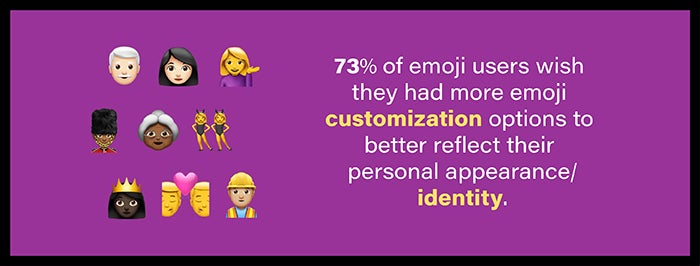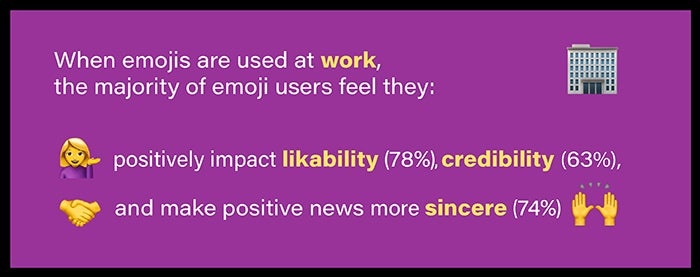The Cultural Phenomenon of Emoji
Key Takeaways from the 2019 Emoji Trend Report.

Emojis have become a cultural phenomenon, shaping the way we express ideas and emotions across languages, friends, and generations. However, they’re much more than just fun characters we exchange in texts, tweets, and emails. They’re also the primary motivation behind an innovative font technology called color fonts.
This emerging font technology enables features such as color, gradients, and textures to appear in a font file. Color fonts allow text to be shown with these graphic qualities while still allowing it to be edited, indexed, or searched. At Adobe Fonts, we’re proud to provide support of color fonts in Illustrator, InDesign, and Photoshop, and are excited to see the continued expansion of emoji color fonts available as more creatives and brands create their unique spin on emojis today.
This World Emoji Day, we’re excited to unpack the cultural phenomenon of emoji with the release of our first-ever Update: see the 2021 Emoji Trend Report. In this year’s report, we surveyed 1,000 emoji users in the U.S. to learn more about the impact of this emerging digital language on our lives, relationships, and communications — uncovering where, when, why, and how people are using emojis, and their thoughts on the future of the digital characters.
As we look to the future, emojis will play a key role in advancing communication to create a more connected world. Here are some of my top takeaways from the report:
Emojis bring joy, bridge barriers, and encourage the sharing of thoughts and ideas
Among the emoji users surveyed, the overwhelming majority use emojis to lighten the mood of conversations (93%) and show support to people (91%). Aligned with this finding, emoji users’ top three favorite emojis are 😂 (#1), ❤️ (#2), 😘 (#3).

Interestingly, a majority (81%) of emoji users believe that people who use emojis are friendlier and more approachable (😻‼️). When asked about emojis’ greatest benefits, a majority of emoji users highlight the ability to communicate across language barriers (94%) and instantly share thoughts and ideas (90%).

We also found some interesting insights on emoji users’ preferences for using the digital characters to convey their emotions. Surprisingly, 65% of emoji users are more comfortable expressing their emotions through emojis than a phone call. This is especially true for Gen Z’ers (83%), which is now the single largest population segment.

Emoji users want more inclusive and representative emojis
Notably, 78% of emoji users agree emojis should continue to strive for inclusivity, and 73% wish they had more emoji customization options to better reflect their personal appearance and identity.

My pal and colleague Paul Hunt has been advocating for these issues for some time now. “It’s inspiring to see such strong interest among emoji users in the continued expansion of emoji. As a Unicode Emoji Subcommittee member and creator of the gender inclusive emojis and the orange heart emoji (to complete the colors of the rainbow). I’m deeply passionate about championing the addition of more representative and inclusive emojis in the Unicode Standard. I’m excited to see some of the newest emojis in the latest release addressing important topics such as the drop of blood emoji, emojis representing people with disabilities and the gender inclusive couple. Looking ahead, I’m optimistic that we’ll continue to see more emojis that represent us all.”
Read more: Towards a diverse and inclusive future for emoji
Emoji use thrives and fuels positive perception in the workplace
Don’t use emojis at work? You might want to. Among the emoji users we surveyed, 61% exchange emojis at work. When emojis are used at work, the majority of emoji users feel they positively impact likability (78%) and credibility (63%) and make positive news more sincere (74%). As the popularity of emojis continues to increase, I believe people are becoming more comfortable using them as part of everyday personal and professional communication.

Emojis can unlock business opportunities
From ordering Domino’s by simply texting a 🍕 emoji, or Disney’s As Told by Emoji series, brands are looking to capture consumer attention in unique, fun ways with emojis. Notably, over half (58%) of emoji users are more likely to open an email 📨 from a brand that has an emoji in the subject line. Nearly half (44%) of emoji users are more likely to purchase products advertised using emojis. Surprisingly, a majority (64%) of emoji users are willing to make a purchase with an emoji – most likely purchasing meals 🌮 (19%), movie tickets 🎟 (15%) and clothing 👗👔👟 (13%).

I’m sure the best days of emoji are ahead of us, and so are emoji users — more than three-fifths agree emojis will be better developed and more progressive in the next five years.
Read the full findings from our 2019 Adobe Emoji Trend Report here.